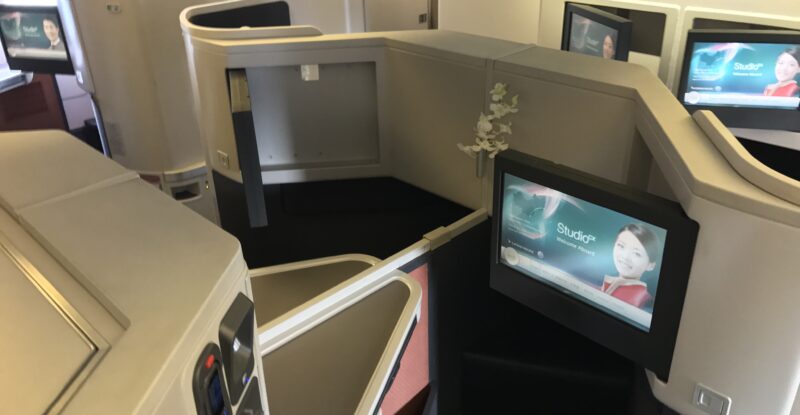 2024 looks set to be a bumper year for a new generation of business class cabins arriving onto aircraft, so it’s perhaps fitting that your author closed out last December flying on the seat that is the epitome of the first generation of fully flat beds with direct aisle access: the Cathay Pacific version of Safran Seats’ Cirrus, highly customised in partnership with JPA Design. (Full disclosure, as ever: Cathay flew me out to Hong Kong to talk passenger experience and review the flights.)
2024 looks set to be a bumper year for a new generation of business class cabins arriving onto aircraft, so it’s perhaps fitting that your author closed out last December flying on the seat that is the epitome of the first generation of fully flat beds with direct aisle access: the Cathay Pacific version of Safran Seats’ Cirrus, highly customised in partnership with JPA Design. (Full disclosure, as ever: Cathay flew me out to Hong Kong to talk passenger experience and review the flights.)
At the time of its creation, direct aisle access in business dated back only to 2003 with Virgin Atlantic’s Upper Class Suite, and Cathay had its own inward-facing herringbone seat, the controversial Contour Solar Eclipse whose high walls quickly gave it the nickname of coffin class. Cirrus, meanwhile, was launched by the erstwhile US Airways in 2008-09, as first revealed by RGN editor, then Flightglobal senior editor Mary Kirby — but Cathay’s improvements to the seat cemented it as a passenger favourite.
These improvements are still lessons that might well be learned by seat designers today, especially around being a seat that just gets out of the way of passengers to provide movement space and passive comfort.
One example: the way that the cutout underneath the side table both provides storage space and allows side-sleepers to curl their knees up. Another: the curving triangular gap at the front end of the side table removes the point at which passengers would bang their knees when rolling over. A third: the amount of space in the footwell for larger-hoofed passengers to fit their bigger feet.
Recent business class experiences either had not learned those lessons or they had been ignored — or eschewed, or disappeared in tradeoffs — by seatmakers, airlines, designers or a combination of all three.
As I discussed in my recent review of the Cathay business experience, the control panel is strikingly practical, accessible, and comprehensible, something that a frankly disturbing number of modern business class seats lack thanks to either a fiddly capacitative screen controller or an unhelpful row of tiny buttons with tinier pictograms that passengers without 20/20 vision — or simply sleepy slumberers — find a faff.

The Cathay Cirrus control panels look a little clunky in places these days, but functionally they are superb. Image: John Walton
The seat isn’t perfect, of course, and its aesthetic has aged. There are a lot of large, flat, greige thermoplastics, although even brand new seats are guilty of this sin. In particular, the expanse of vertical greige thermoplastic shrouding at eye level lends itself to the “serried ranks” effect, where if seated at the rear of the larger business cabin there are a lot of rows repeating into the far distance. Solutions to this include mood lighting, metal elements and light-catching mica effects à la Virgin Atlantic A330neo, or even just curving that eye-level panel upwards to catch reflections like Starlux’s Collins Elements cabin.
Another lesson learned from this seat is technical upgradeability, and not just the pre-Lightning iPod 30-pin connector adaptor that became obsolete in 2012.

The iPod connector is a classic example why technological upgradeability is needed. Image: John Walton
During a wide-ranging chat with Cathay’s Vivian Lo about the forthcoming Aria business class seat in Hong Kong on this trip, we discussed that lesson, the lesson of the seatback screens that are now unacceptably low resolution, and the lesson from the 2012 regional business recliner, where the size of standard smartphones quickly outgrew the seatback storage slot designed for them.
With business classes a decade on now employing the principle of using zones of flexible customisation — and indeed flexible upgradeability — much of this question should now be easier to improve as expectations increase over the years.
But what can’t be so easily improved is the base quality of the seat, and that should be food for designers’ thought.
Cathay’s has stood it in excellent stead for what will be more than a decade and a half by the time that the combination of new Aria seats and aircraft retirements replace it.
Related Articles:
- Cathay’s Vivian Lo talks design language of new Aria business suite
- Recaro’s Dr. Mark Hiller on how aircraft seats are evolving
- The new cabins of 2024 — and what they will tell us about aviation
- Cathay’s revamped business soft product is as strong as OG Cirrus
- Cathay can draw inspiration for new first class from iconic product
- Cathay’s Aria business seat tease spurs big interest
All images of Cathay Pacific‘s Cirrus business class credited to John Walton














